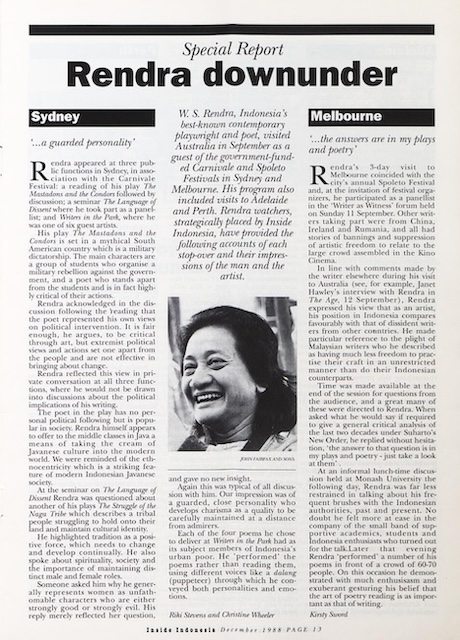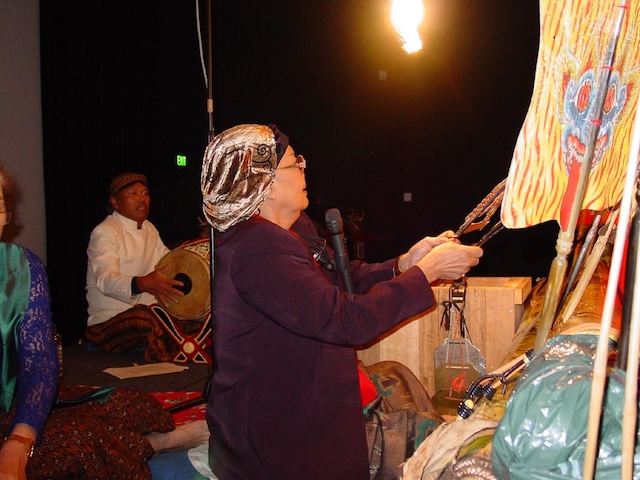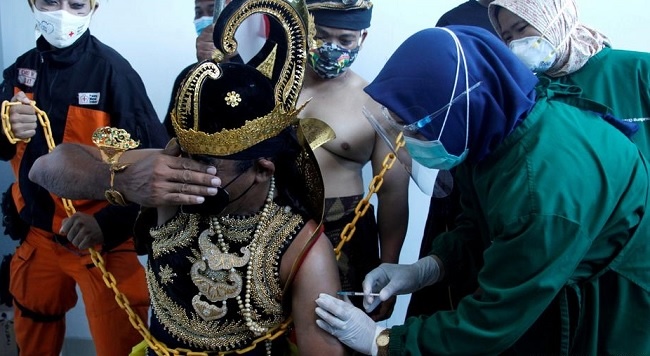Forty years of theatre coverage in Inside Indonesia
Barbara Hatley
Performance in Indonesia, as well as providing entertainment, also participates significantly in everyday life. Reporting on that social engagement contributes importantly to Inside Indonesia’s exploration of social and political issues like inequality, authoritarianism and human rights in the country.
The early years of publication include several articles highlighting the work of the poet, playwright and director, Rendra. ‘Rendra Downunder’, an account of Rendra’s tour of Australia in 1988, includes a discussion by Rendra of the ‘mission’ of his theatre group in Yogyakarta, Teater Bengkel. Artists need to take sides, he said, to work for social change. ‘Any change is meaningless unless its objective is freedom and equality for all’.
My own article ‘Not by Royal Command’ describes Rendra’s activities with Bengkel theatre. His plays satirically portrayed corrupt government officials and exploitative economic development. Youthful audience members roared approval as the characters voiced views ‘they shared but could only express in mute, partial fashion’. When Bengkel was no longer able to perform due to banning by the government, the ‘legacy’ of Bengkel’s mission of political critique was passed on to the groups Dinasti and Gandrik. In Solo meanwhile the group Gapit gave expression to ‘the outrage of little people buffeted by social forces beyond their control’. Small kampung-based student groups involved local people directly in plays about everyday social issues.

Another question addressed at this time is the portrayal in performance of gender relations and women’s social roles. Helen Pausacker in ‘Limbuk wants to be a dalang’ focuses on the Javanese shadow puppet theatre, wayang kulit. She reports that women puppeteers (the dalang) are very rare, and seventy percent of the characters in performances are male. Women characters are the wives and sweethearts of males, along with two clown maidservants, Limbuk and her mother Cangik. A major concern in performances by male dalang is finding a husband for Limbuk, while in several shows by women Limbuk asserts that she’s not interested in marrying, she wants to be a dalang herself.
Women
An article of mine ‘Women in Javanese Popular Theatre’ describes the role of women characters and performers in the popular theatre form ketoprak. While most women characters, as queens and princesses, are refined, shy and submissive, a few are vivacious and assertive. As they chide their husband or sweetheart for his jealousy, infidelity or neglect, women audience members often laugh and clap, while men glower or grumble derisively. Although women need to defer to men in real life as on the stage, popular theatre provides opportunity for assertion of women’s views alongside those of men.
After 1998 in the post-Reformasi period, types of performances discussed in contributions to Inside Indonesia became more numerous and diverse. Helen Pausacker and Bob Muntz interview performance artists Gesti and Lieswati, about their activities with women factory workers, and Sadiah Boonstra writes about wayang Islam. Guitar music and Arabic religious chants combine with the sounds of gamelan in stories about everyday life that include Islamic practices. In this way wayang extends to a much wider audiences, especially young people.

The work of the artist Moelyono is discussed by Tom Plummer, in his article ‘Art for a better World’. Moelyono brings together villagers in East Java forced off their land because of a dam project. They practise a trance dance called jaranan, which releases tensions and creates a sense of unity. Lauren Bain reviews theatre initiatives of non-government organisations. Often seen as simplistic and didactic, these can in fact be ‘rough but genuine’, involving ordinary people and based on their own experiences. They increase opportunities for artists and NGOs to work together both in Indonesia and internationally.
Many articles focus on Indonesian performances staged in Australia, particularly at festivals, in Adelaide and Asiatopa in Melbourne. Others review Australian-Indonesian collaborations in performance. For The Theft of Sita, director Nigel Jamieson and composer Paul Grabowsky worked together with Balinese dalang I Made Sidia. The Melbourne Symphony orchestra accompanied Satan Jawa, a film by Garin Nugroho. Teater Satu from Lampung collaborated with Australian playwright Sandra Thibodeau, and Main Teater from Bandung with a student group from La Trobe University.
Discussions of performance also confirm the pattern noted for Inside Indonesia articles generally, namely an increasing number of contributions by Indonesians. The article by Muhamad Abe and Andy SW, for example, refutes the view that Indonesian theatre has lost connection with society and ordinary people. They cite many examples of other groups in Jakarta, Yogya, Solo, Bandung and Lampung ‘trying to build theatre culture in a contemporary context, interacting with ordinary people… strengthening their sense of participation in a dynamic and diverse new movement’.
COVID-19
In a 2021 edition of Inside Indonesia focused on the impact of COVID-19 on performance and performers, all the contributors are Indonesian. They come from different regions: Java, Bali, Sumatra, Flores. The impact of the pandemic was often severe. Nicodemus Freddy Hadiyanto in his article about performing artists in Bali - heavily dependent on tourism – regrets the loss of income and of the opportunity to gather. But other articles discuss the new opportunities and skills which COVID-19 provided.

Eka Putra Nggalu writes of the way online performances by theatre groups gave artists in Flores chances for learning and interaction they’d never had previously. And Elyandra Widharta describes the way his group developed a new kind of creativity by working with digital media. They recorded short performances and made them widely available on their own youtube channel. Teater Satu in Lampung was able to continue to give acting classes and to analyse artistic practice on youtube. Ibed S Yuga of Kalinari Theatre focused on publishing plays ‘with the aim of extending discussion and knowledge of theatre through literary creation.’
Now that things have opened up again, performance is re-emerging too. Elyandra Widharta tells me that his group Sedhut Senut has since January 2023 been able to perform live again. They no longer have to perform via digital media, but they’re happy they’ll be able to draw on their skills in this field if needed. They’ve been strengthening their own group abilities, and holding workshops with other groups focusing on characterisation, lighting and other aspects of staging. Sedhut Senut also organised a festival of Javanese language drama performances involving groups in different kabupaten of the Yogyakarta Special Region.
Now they are considering touring internationally, to countries where there is a Javanese community, and/ or Javanese language is taught, to hold workshops with other groups and stage mini performances. Holland, particularly Leiden, is the most likely country to be interested. And perhaps also Australia?
Nicodemus Freddy Hadiyanto has similarly told me that night club performers and disc jockeys in Bali are very glad to be performing again. However they are suffering some financial difficulty. In their delight at re-emerging on stage they agreed to accept lower wages than they are due.
Eka Putra Nggalu lets me know his group Kahe is once more performing live. But he also stresses the importance of ongoing benefits of connections formed during COVID-19, which led to invitations to participate in online meetings involving theatre producers in other regions of Indonesia and countries in Southeast Asia.
What’s happening with theatre staged by other groups, in other sites in Indonesia today? Perhaps a good time for an Inside Indonesia update?
Barbara Hatley (barbara.hatley@utas.edu.au) is Emeritus Professor in Humanities at the University of Tasmania. She has published widely on Indonesian theatre.












